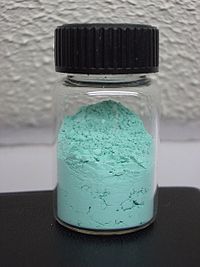- Copper(II) carbonate
-
Copper(II) carbonate  Other namescopper carbonate, cupric carbonate, basic copper carbonate
Other namescopper carbonate, cupric carbonate, basic copper carbonateIdentifiers CAS number 1184-64-1 PubChem 14452 ChemSpider 13799 
RTECS number FF950000 Jmol-3D images Image 1 - [Cu+2].[O-]C([O-])=O
Properties Molecular formula CuCO3 Molar mass 123.555 g/mol Density 3.9 g/cm3 Melting point 200 °C
Boiling point decomposes at 290 °C
Solubility in other solvents insoluble in water, found effective in melting ice, soluble in ethanoic acid Hazards MSDS Oxford MSDS  carbonate (verify) (what is:
carbonate (verify) (what is:  /
/ ?)
?)
Except where noted otherwise, data are given for materials in their standard state (at 25 °C, 100 kPa)Infobox references Copper(II) carbonate (often called copper carbonate or cupric carbonate) is a blue-green compound (chemical formula CuCO3) forming part of the verdigris patina that is found on weathered brass, bronze, and copper. The colour can vary from bright blue to green, because there may be a mixture of both copper carbonate and basic copper carbonate in various stages of hydration. It was formerly much used as a pigment, and is still in use for artist's colours. It has also been used in some types of make-up, like lipstick, although it can also be toxic to humans. It also has been used for many years as an effective algaecide in farm ponds and in aquaculture operations. Copper carbonate was the first compound to be broken down into several, separate elements (copper, carbon, and oxygen). It was broken down in 1794 by the French chemist Joseph Louis Proust (1754–1826). When burnt, it thermally decomposes to form CO2 and CuO, a black solid. It can be used to copper plate a metallic surface by adding sulfuric acid and heat it (to produce copper sulfate) then passing a charge through it with the metal in the liquid. This process is known as electroplating.
Copper in moist air slowly acquires a dull green coating because its top layer has oxidised with the air. Some architects use this material on rooftops for this interesting colour. The green material is a 1:1 mole mixture of Cu(OH)2 and CuCO3:[1]
- 2 Cu (s) + H2O (g) + CO2 + O2 → Cu(OH)2 + CuCO3 (s)
Copper carbonate decomposes at 290 °C, giving off carbon dioxide and leaving copper(II) oxide:
- CuCO3 (s) → CuO (s) + CO2 (g)
Basic copper(II) carbonate occurs naturally as malachite (Cu2(OH)2CO3) and azurite (Cu3(OH)2(CO3)2).
Contents
Preparation
Copper carbonate is prepared by combining aqueous solutions of copper sulfate and sodium carbonate. Copper basic carbonate precipitates from the solution:
- 2 CuSO4 + 2 Na2CO3 + H2O → Cu2(OH)2CO3 + 2 Na2SO4 + CO2
The formation of copper carbonate can be verified in the following steps: a) Centrifuge the above mentioned solution, 1 minute at 6000 g is sufficient b) Wash the precipitate with distilled water and centrifuge again c) The colour of the precipitate is blue, like that of several copper salts but none of the sodium salts d) If dilute (1M) hydrochloric acid is added, then bubbles of CO2 will emerge and the precipitate will be fully solubilised. These would not be formed if dilute hydrochloric acid was added to solid Na2SO4.
Pure copper carbonate is obtained from basic copper carbonate in the presence of carbon dioxide at 180 °C and 4.6 MPa (46 atm) pressure.[citation needed]
Reactions
1) Reaction with acids:
copper carbonate reacts with acids and gives carbon dioxide and corresponding copper(II) salts of that acid:
- copper carbonate + hydrochloric acid → copper chloride + water + carbon dioxide:
- CuCO3 + 2HCl → CuCl2 + H2O + CO2
- copper carbonate + sulfuric acid → copper sulfate + water + carbon dioxide:
- CuCO3 + H2SO4 → CuSO4 + H2O + CO2
- copper carbonate + nitric acid → copper nitrate + water + carbon dioxide:
- CuCO3 + 2HNO3 → Cu(NO3)2 + H2O + CO2
- copper carbonate + acetic acid → copper acetate + water + carbon dioxide:
- CuCO3 + 2CH3COOH → Cu(CH3COO)2 + H2O +CO2
2) Decomposition:
- copper carbonate decomposes at 290°C and forms copper(II) oxide:
CuCO3 → CuO + CO2
References
- ^ Masterson, W. L., & Hurley, C. N. (2004). Chemistry: Principals and Reactions, 5th Ed. Thomson Learning, Inc. (p 498).
External links
Copper compounds Categories:- Carbonates
- Copper compounds
- Pyrotechnic colorants
Wikimedia Foundation. 2010.

